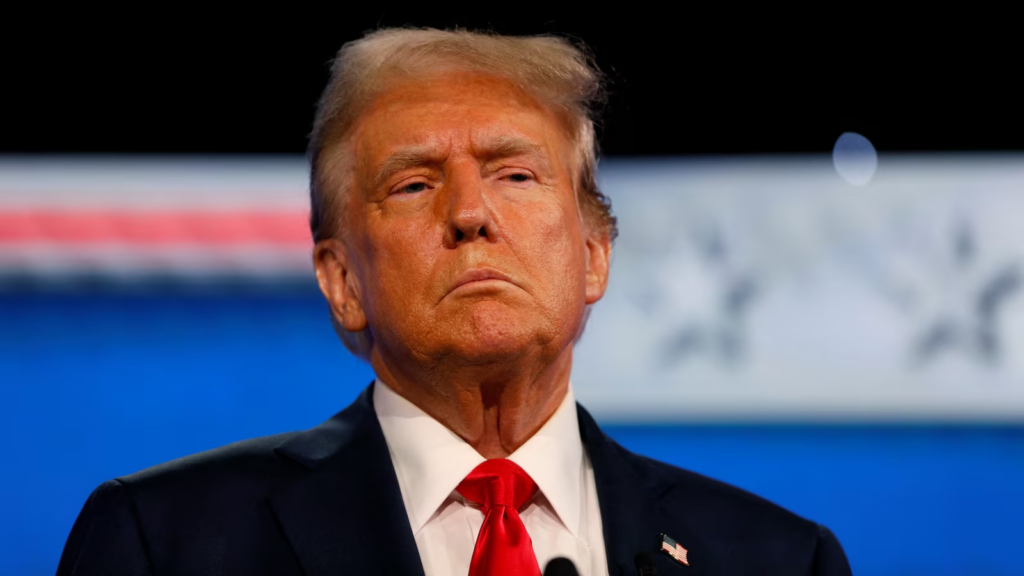How Trump Would Weaponize the Justice Department
The former president has repeatedly tried to prosecute his political opponents, whom he dubs “the enemy within.” In a second term, he actually could.
Former President Donald Trump has made it clear what he’d like to do with the Department of Justice if he’s reelected: go after his political opponents. As he has posted on social media, “WHEN I WIN, those people that CHEATED” — Democrats, in his dark fantasy of election fraud — “will be prosecuted to the fullest extent of the Law, which will include long term prison sentences so that this Depravity of Justice does not happen again.” It would be foolish to dismiss such promises as mere bluster.
Trump’s words echo refrains from his first administration, when the former president used social media to call for the prosecutions of Hillary Clinton, Joe Biden, Hunter Biden, Barack Obama, James Comey, and members of Congress including Nancy Pelosi, Adam Schiff and Ilhan Omar. For example, in July 2017, Trump posted, “So many people are asking why isn’t the A.G. or Special Council (sic) looking at the many Hillary Clinton or Comey crimes. 33,000 e-mails deleted?”
Trump was also “obsessed” with prosecuting John Kerry, the secretary of state under Obama, according to former Trump National Security Adviser John Bolton. Bolton wrote in his book that “in meeting after meeting in the Oval, Trump would ask Attorney General William Barr or anybody listening to launch a prosecution.”
These efforts to initiate criminal probes of his rivals failed for two reasons. First, experienced DOJ aides discouraged these authoritarian instincts. And second, abusing the powers of the presidency carried the risk of criminal prosecution. Both of those checks will be missing in a second term. Trump has vowed to appoint loyalists a second time around. And the Supreme Court has defanged the threat of prosecution with its sweeping immunity ruling.
Start with Trump’s advisers. Both of Trump’s first-term attorneys general largely respected the norms of the department they led, the Department of Justice. The first, Jeff Sessions, was confronted with evidence that the Trump campaign had received assistance from Russia in the 2016 election and subsequently recused himself from the investigation because of his work on the campaign. That allowed his deputy, Rod Rosenstein, to hire a special counsel — Robert Mueller — to investigate potential crimes that could implicate his bosses. That was appropriate — and infuriated Trump.
Trump’s second AG, William Barr, was a little more of a loyalist when it came to the Russian investigation. He dismissed the case against Trump ally Michael Flynn (charged with lying to the FBI) and recommended a lighter sentence for Roger Stone (convicted of obstruction, witness tampering and lying to Congress).

But Barr publicly refuted Trump’s false claims of voter fraud, again infuriating Trump. Barr ultimately resigned from office. According to testimony presented at the Jan. 6 congressional hearings, Trump’s hope of appointing a loyalist as acting attorney general to facilitate election fraud was thwarted when other top DOJ officials and White House counsel threatened to resign.
This time around, don’t expect such independence. Trump has said that in 2016, his appointees “were not what I really wanted because I didn’t know much about Washington.” Since then, he has learned. “And now I know the good ones, the bad ones, the weak ones, the smart ones, the dumb ones. I know them all now.”
In a second Trump term, we can expect an attorney general who is a Trump loyalist, one who may be willing to help fulfill Trump’s dreams of vengeance. If Trump is unable to persuade the Senate to confirm this person, we may see Trump follow the pattern he used at the end of his first term by appointing acting cabinet officials. Acting attorneys general serve limited terms, but Trump could simply replace AGs as needed with a revolving door of yes-men. When loyalty is what matters most, continuity of leadership is less important.
Trump could also go after lower-ranking DOJ officials. The bulk of the agency’s employees are career professionals — the very people Trump has so often referred to as the “deep state,” in part because of their tendency to resist illegal orders. His frustration led him to impose, via executive order, Schedule F, a regulation that permitted the removal of civil servants with policymaking responsibilities at the will of the president. President Joe Biden rescinded Schedule F, but it could be reinstated with a stroke of his successor’s pen. Under Schedule F, those who resist Trump would be replaced by those who will obey.
Then there’s the fallout of the Supreme Court’s immunity ruling. In light of the court’s decision in July that a president is immune from criminal prosecution for official acts committed in office, Trump would be freed in a second term from the specter of any special counsel investigations.
Mueller investigated not only Trump’s activities as a candidate, but also his efforts as president to obstruct the investigation. That topic would be off limits under the court’s decision. As the dissenting justices noted in that case, a president would be immune from prosecution even if he “[o]rders the Navy’s Seal Team 6 to assassinate a political rival,” “[o]rganizes a military coup to hold onto power,” “or “takes a bribe in exchange for a pardon,” a claim the majority did not refute. And although it is unclear whether subordinates who carry out a president’s illegal orders are themselves immune from criminal prosecution, Trump could simply pardon them for any misconduct.
The only remaining remedy for a president who abuses his official powers is impeachment, which we saw in the last administration is a weak tool. Trump was impeached twice, but Republican senators were reluctant to convict and remove from office a member of their own party.
One would hope that any of Trump’s rivals who find themselves in the crosshairs of his DOJ would find protection from conviction in the institutional checks in our criminal justice system, such as the grand jury process, due process, impartial judges, and the jury system requiring guilt beyond a reasonable doubt. But even undergoing investigation can cause harm to public figures, who must spend time, money and effort defending themselves. And the endless investigation of baseless claims would divert the Department of Justice from focusing on the real crimes.
Our Constitution created a system of checks and balances designed to protect us from abuses of power, but those checks are imperfect. In a second Trump administration, the president would have a much clearer path to run right through them.
Audi’s busy adding to its roster of e-tron electric vehicles, and the latest to debut is the 2025 A6 e-tron, a sleek sedan with all of the brand’s cutting-edge technology. Audi expects EPA range to be as much as 390 miles per charge. The A6 e-tron is powered by a rear-mounted electric motor with 375 horsepower, while the A6 e-tron Quattro adds a second motor for all-wheel drive and bumps power to 456 ponies. If you want more, you’ll have to spring for the high-performance S6 e-tron, whose dual-motor powertrain produces a combined 543 hp. Unlike the gasoline-powered A6 sedan, the A6 e-tron hides a hatchback in its sloped rear roofline (making it a Sportback in Audi-ese), under which is a large cargo area similar to that of the current A7. Inside, there’s a full roster of infotainment features, plenty of standard amenities, and enough interior room for four adults to travel comfortably for long distances.
The A6 e-tron comes with a 375-hp electric motor driving the rear wheels, but the A6 e-tron Quattro comes with a dual-motor, all-wheel drive setup with 456 horsepower. The performance-oriented S6 e-tron boasts 543 horsepower, but we review that model separately. An air spring suspension system is optional and provides adaptive dampers with unique driving modes; it can also lower the A6 e-tron’s ride height for improved aerodynamic efficiency. When we drove the A6 e-tron, we found its driving dynamics to be ho-hum but appreciated its adjustable levels of regenerative braking capability.
According to Audi, the A6 e-tron can reach 62 mph in 5.2 seconds and the Quattro version can do it in 4.3. When we have the opportunity to test an A6 e-tron, we’ll update that number with real-world data.
A 94.4-kWh battery pack is expected to deliver an EPA range of 370 miles in the rear-wheel-drive A6 e-tron, with an available Ultra package stretching that to 390 miles. The all-wheel-drive version is estimated to bring an EPA range of 333 miles, or 375 with the Ultra package. (Although we’re still awaiting official EPA numbers.) DC fast-charging capability is standard, and Audi claims a max charging rate of 270 kilowatts. That means the A6 e-tron should be able to charge its battery from 10 percent to 80 percent of capacity in just 21 minutes.



